Machine Learning Insight into the Cooling Intensity of Urban Blue-Green Spaces During Heatwaves
Abstract
1. Introduction
1.1. Research Background and Motivation
1.2. Previous Works
1.3. Research Gaps
1.4. Research Objectives
- (i)
- Evaluate CI: We assess the current CI of urban blue-green spaces in Hue’s urban center using remote sensing data.
- (ii)
- Model nonlinear relationships: This study investigates how CI is influenced by multiple variables related to blue-green infrastructure through advanced machine learning approaches. Specifically, XGBoost and SHAP are used for explainable modeling.
- (iii)
- Analyze environmental interactions: We examine the interplay between blue-green space—related features and the surrounding urban environment, employing quantitative methods to unravel their combined impact on cooling effectiveness.
- (iv)
- Identify key influencing factors: Via SHAP, it is able to explore which landscape pattern characteristics and types of blue-green spaces deliver more consistent and robust cooling effects, particularly during extreme heat events.
- (v)
- Implications for urban planning: The research findings aim to provide insights to support the spatial layout and optimization of blue-green infrastructure in Hue City and neighboring regions.
2. Research Method and Materials
2.1. General Description of the Study Area and Remote Sensing Datasets
2.2. Land Surface Temperature Retrieval
2.3. Cooling Intensity and Its Explanatory Variables
- (i)
- Topographical variables: average elevation, slope, aspect, topographic position index (TPI).
- (ii)
- Landscape composition: percentages of landscape (PLAND) of bareland, shrubland, tree canopy, and waterbody.
- (iii)
- Proximity features: average distance to coastline, river, road, shrubland, tree canopy, and waterbody.
2.4. Extreme Gradient Boosting Machine for Nonlinear Function Approximation
2.5. Shapley Additive exPlanations (SHAP)
2.6. Metrics for Model Performance Evaluation
3. Cooling Intensity Predicting Results
3.1. Prediction Performance
3.2. SHapley Additive exPlanations (SHAP)
4. Discussion
4.1. Prediction Performance of the Machine Learning Framework
4.2. Cooling Intensity (CI) in Hue’s Urban Center
4.3. Urban Planning Implications for Enhancing Blue-Green Space’s Cooling Intensity
4.4. Research Limitations and Future Works
- (i)
- Additional urban and landscape parameters should be taken into account to enhance the current approach’s generalization.
- (ii)
- Integrating higher-resolution geospatial data from advanced thermal sensors, aerial surveys, and meteorological stations can help validate and enhance the accuracy of the CI analyses. In particular, higher resolution data can also help achieve finer distinctions among subtypes of the shrubland category. Moreover, field-based thermal measurements should also be conducted to better differentiate cooling-effective from non-effective vegetation types.
- (iii)
- Future works should include more detailed field investigations and analyses using higher-resolution remote sensing data to refine the classification thresholds based on EVI and improve vegetation differentiation across different sections of the study area.
- (iv)
- Another possible extension of this research would be to conduct a sensitivity analysis of CI modeling results across different block sizes, including finer spatial units. Based on such analysis, it would be able to evaluate how spatial scale influences model performance and urban heat mapping. It is also worth investigating how the scale of analysis corresponds to the up-to-date planning units in Hue City. Aligning the scale of the analysis with official planning units will definitely enhance the applicability of the proposed framework for practitioners and policymakers, particularly for district- and ward-level urban planning.
- (v)
- Advanced statistical and quantitative methods can be applied to systematically identify and validate optimal PLAND threshold ranges for both green spaces and water bodies to support landscape planning in the study area.
- (vi)
- Future research should incorporate a detailed feasibility assessment of the LULC planning regarding heat stress alleviation, specifically for Hue’s dense historic core. This assessment should consider both spatial and economic constraints, such as land availability, implementation costs, and heritage preservation.
- (vii)
- Future works should also explore direct links between heat exposure and a range of public health outcomes. Integrating public health datasets—including statistics on heat-related morbidity, mortality, and mental health during heat waves—will enable urban planners and local authorities to better understand, predict, and address heat stress risks, with a particular focus on vulnerable hotspots exhibiting weak or negative CI.
5. Conclusions
Author Contributions
Funding
Institutional Review Board Statement
Informed Consent Statement
Data Availability Statement
Conflicts of Interest
References
- Veerkamp, C.J.; Schipper, A.M.; Hedlund, K.; Lazarova, T.; Nordin, A.; Hanson, H.I. A review of studies assessing ecosystem services provided by urban green and blue infrastructure. Ecosyst. Serv. 2021, 52, 101367. [Google Scholar] [CrossRef]
- Deilami, K.; Kamruzzaman, M.; Liu, Y. Urban heat island effect: A systematic review of spatio-temporal factors, data, methods, and mitigation measures. Int. J. Appl. Earth Obs. Geoinf. 2018, 67, 30–42. [Google Scholar] [CrossRef]
- Wang, C.; Chang, H.-T. Hotspots, Heat Vulnerability and Urban Heat Islands: An Interdisciplinary Review of Research Methodologies. Can. J. Remote Sens. 2020, 46, 532–551. [Google Scholar] [CrossRef]
- Ulpiani, G. On the linkage between urban heat island and urban pollution island: Three-decade literature review towards a conceptual framework. Sci. Total Environ. 2021, 751, 141727. [Google Scholar] [CrossRef]
- Gupta, A.; De, B. A systematic review on urban blue-green infrastructure in the south Asian region: Recent advancements, applications, and challenges. Water Sci. Technol. 2024, 89, 382–403. [Google Scholar] [CrossRef]
- Na, N.; Lou, D.; Xu, D.; Ni, X.; Liu, Y.; Wang, H. Measuring the cooling effects of green cover on urban heat island effects using Landsat satellite imagery. Int. J. Digit. Earth 2024, 17, 2358867. [Google Scholar] [CrossRef]
- Cartwright, E.D. The Hottest Year in Record and What Sea Sponge Tells Us About Climate Change. Clim. Energy 2024, 40, 13–19. [Google Scholar] [CrossRef]
- Martel, J.-L.; Brissette, F.P.; Lucas-Picher, P.; Troin, M.; Arsenault, R. Climate Change and Rainfall Intensity–Duration–Frequency Curves: Overview of Science and Guidelines for Adaptation. J. Hydrol. Eng. 2021, 26, 03121001. [Google Scholar] [CrossRef]
- WHO. COP24 Special Report: Health and Climate Change. 2018. Available online: https://unfccc.int/sites/default/files/resource/WHO%20COP24%20Special%20Report_final.pdf (accessed on 8 September 2025).
- Kjellstrom, T.; Briggs, D.; Freyberg, C.; Lemke, B.; Otto, M.; Hyatt, O. Heat, Human Performance, and Occupational Health: A Key Issue for the Assessment of Global Climate Change Impacts. Annu. Rev. Public Health 2016, 37, 97–112. [Google Scholar] [CrossRef]
- Obradovich, N.; Migliorini, R.; Paulus, M.P.; Rahwan, I. Empirical evidence of mental health risks posed by climate change. Proc. Natl. Acad. Sci. USA 2018, 115, 10953–10958. [Google Scholar] [CrossRef]
- Ballester, J.; Quijal-Zamorano, M.; Turrubiates, R.F.M.; Pegenaute, F.; Herrmann, F.R.; Robine, J.M.; Basagaña, X.; Tonne, C.; Antó, J.M.; Achebak, H. Heat-related mortality in Europe during the summer of 2022. Nat. Med. 2023, 29, 1857–1866. [Google Scholar] [CrossRef]
- Hoang, T.L.T.; Dao, H.N.; Cu, P.T.; Tran, V.T.T.; Tong, T.P.; Hoang, S.T.; Vuong, V.V.; Nguyen, T.N. Assessing heat index changes in the context of climate change: A case study of Hanoi (Vietnam). Front. Earth Sci. 2022, 10, 897601. [Google Scholar] [CrossRef]
- Thanh, P.N.; Le Van, T.; Thi, X.A.T.; Hai, A.N.; Le Cong, C.; Gagnon, A.S.; Pham, N.T.; Anh, D.T.; Dinh, V.N. Predicting drought stress under climate change in the Southern Central Highlands of Vietnam. Environ. Monit. Assess. 2024, 196, 636. [Google Scholar] [CrossRef] [PubMed]
- Thi, L.P.; Thanh, H.P.; Van, T.P.; Thuan, Y.V. Variability of heatwaves across Vietnam in recent decades. Vietnam J. Earth Sci. 2023, 45, 517–530. [Google Scholar] [CrossRef]
- Hoang, N.-D.; Tran, V.-D.; Huynh, T.-C. From Data to Insights: Modeling Urban Land Surface Temperature Using Geospatial Analysis and Interpretable Machine Learning. Sensors 2025, 25, 1169. [Google Scholar] [CrossRef]
- Pham-Thanh, H.; Pham-Thi, L.; Phan, H.; Fink, A.H.; van der Linden, R.; Phan-Van, T. Heatwaves in Vietnam: Characteristics and relationship with large-scale climate drivers. Int. J. Clim. 2024, 44, 4725–4740. [Google Scholar] [CrossRef]
- Lohrey, S.; Chua, M.; Gros, C.; Faucet, J.; Lee, J.K.W. Perceptions of heat-health impacts and the effects of knowledge and preventive actions by outdoor workers in Hanoi, Vietnam. Sci. Total Environ. 2021, 794, 148260. [Google Scholar] [CrossRef]
- Nguyen, V.T.; Doan, Q.-V.; Tran, N.N.; Luong, L.T.M.; Chinh, P.M.; Thai, P.K.; Phung, D.; Le, H.H.T.C.; Dang, T.N. The protective effect of green space on heat-related respiratory hospitalization among children under 5 years of age in Hanoi, Vietnam. Environ. Sci. Pollut. Res. 2022, 29, 74197–74207. [Google Scholar] [CrossRef]
- Liu, Q.; Dong, Q.; Zhang, L.; Sun, C. Summer cooling island effects of blue-green spaces in severe cold regions: A case study of harbin, China. Build. Environ. 2024, 257, 111539. [Google Scholar] [CrossRef]
- Plieninger, T.; Thapa, P.; Bhaskar, D.; Nagendra, H.; Torralba, M.; Zoderer, B.M. Disentangling ecosystem services perceptions from blue infrastructure around a rapidly expanding megacity. Landsc. Urban Plan. 2022, 222, 104399. [Google Scholar] [CrossRef]
- Quan, S.; Li, M.; Li, T.; Liu, H.; Cui, Y.; Liu, M. Nonlinear effects of blue-green space variables on urban cold islands in Zhengzhou analyzed with random forest regression. Front. Ecol. Evol. 2023, 11, 1185249. [Google Scholar] [CrossRef]
- Aram, F.; Higueras García, E.; Solgi, E.; Mansournia, S. Urban green space cooling effect in cities. Heliyon 2019, 5, e01339. [Google Scholar] [CrossRef] [PubMed]
- Budzik, G.; Sylla, M.; Kowalczyk, T. Understanding Urban Cooling of Blue–Green Infrastructure: A Review of Spatial Data and Sustainable Planning Optimization Methods for Mitigating Urban Heat Islands. Sustainability 2025, 17, 142. [Google Scholar] [CrossRef]
- Zhang, Y.; Ge, J.; Wang, S.; Dong, C. Optimizing urban green space configurations for enhanced heat island mitigation: A geographically weighted machine learning approach. Sustain. Cities Soc. 2025, 119, 106087. [Google Scholar] [CrossRef]
- Mallick, J.; Alqadhi, S. Explainable artificial intelligence models for proposing mitigation strategies to combat urbanization impact on land surface temperature dynamics in Saudi Arabia. Urban Clim. 2025, 59, 102259. [Google Scholar] [CrossRef]
- Ullah, S.; Qiao, X.; Abbas, M. Addressing the impact of land use land cover changes on land surface temperature using machine learning algorithms. Sci. Rep. 2024, 14, 18746. [Google Scholar] [CrossRef]
- Hoang, N.-D.; Pham, P.A.H.; Huynh, T.C.; Cao, M.-T.; Bui, D.-T. Geospatial urban heat mapping with interpretable machine learning and deep learning: A case study in Hue City, Vietnam. Earth Sci. Inform. 2024, 18, 64. [Google Scholar] [CrossRef]
- Liu, Z.; Ma, X.; Hu, L.; Liu, Y.; Lu, S.; Chen, H.; Tan, Z. Nonlinear Cooling Effect of Street Green Space Morphology: Evidence from a Gradient Boosting Decision Tree and Explainable Machine Learning Approach. Land 2022, 11, 2220. [Google Scholar] [CrossRef]
- Liu, Z.; Fu, L.; Wu, C.; Zhang, Z.; Zhang, Z.; Lin, X.; Li, X.; Hu, Y.; Ge, H. Spatialized importance of key factors affecting park cooling intensity based on the park scale. Sustain. Cities Soc. 2023, 99, 104952. [Google Scholar] [CrossRef]
- Zeng, J.; Cai, Y.; Yang, C.; Liu, Y.; Liu, W.; Xing, H. Revealing the impact patterns of urban morphology on land surface temperature in the Guangdong-Hong Kong-Macao Greater Bay Area, China. Cities 2025, 165, 106147. [Google Scholar] [CrossRef]
- Gupta, A.; Mora, S.; Preisler, Y.; Duarte, F.; Prasad, V.; Ratti, C. Tools and methods for monitoring the health of the urban greenery. Nat. Sustain. 2024, 7, 536–544. [Google Scholar] [CrossRef]
- Rambhia, M.; Volk, R.; Rismanchi, B.; Winter, S.; Schultmann, F. Prioritizing urban green spaces in resource constrained scenarios. Resour. Environ. Sustain. 2024, 16, 100150. [Google Scholar] [CrossRef]
- Massaro, E.; Schifanella, R.; Piccardo, M.; Caporaso, L.; Taubenböck, H.; Cescatti, A.; Duveiller, G. Spatially-optimized urban greening for reduction of population exposure to land surface temperature extremes. Nat. Commun. 2023, 14, 2903. [Google Scholar] [CrossRef] [PubMed]
- Zhou, W.; Wang, J.; Cadenasso, M.L. Effects of the spatial configuration of trees on urban heat mitigation: A comparative study. Remote Sens. Environ. 2017, 195, 1–12. [Google Scholar] [CrossRef]
- VietNamNet. Multiple Places Hit 40-Degree-Celsius Heatwave. Vietnamnet Global. 2024. Available online: https://vietnamnet.vn/en/multiple-places-hit-40-degree-celsius-heatwave-2266265.html (accessed on 29 August 2025).
- VOV. August 2024 Sees Hot Weather Break Record, Say Meteorologists. Voice of Vietnam. 2024. Available online: https://english.vov.vn/en/society/august-2024-sees-hot-weather-break-record-say-meteorologists-post1118287.vov (accessed on 29 August 2025).
- Patel, S.; Indraganti, M.; Jawarneh, R.N. A comprehensive systematic review: Impact of Land Use/Land Cover (LULC) on Land Surface Temperatures (LST) and outdoor thermal comfort. Build. Environ. 2024, 249, 111130. [Google Scholar] [CrossRef]
- Yu, Z.; Yang, G.; Zuo, S.; Jørgensen, G.; Koga, M.; Vejre, H. Critical review on the cooling effect of urban blue-green space: A threshold-size perspective. Urban For. Urban Green. 2020, 49, 126630. [Google Scholar] [CrossRef]
- Ren, S.; Huang, Z.; Yin, G.; Yan, X.; Dong, Q.; Qi, J.; Zheng, J.; Bao, Y.; Zhang, S. Spatially-optimized greenspace for more effective urban heat mitigation: Insights from regional cooling heterogeneity via explainable machine learning. Landsc. Urban Plan. 2025, 256, 105296. [Google Scholar] [CrossRef]
- Hoang, N.-D.; Nguyen, Q.-L. Geospatial Analysis and Machine Learning Framework for Urban Heat Island Intensity Prediction: Natural Gradient Boosting and Deep Neural Network Regressors with Multisource Remote Sensing Data. Sustainability 2025, 17, 4287. [Google Scholar] [CrossRef]
- Tanoori, G.; Soltani, A.; Modiri, A. Machine Learning for Urban Heat Island (UHI) Analysis: Predicting Land Surface Temperature (LST) in Urban Environments. Urban Clim. 2024, 55, 101962. [Google Scholar] [CrossRef]
- Rana, B.; Bandyopadhyay, J.; Halder, B. Investigating the relationship between urban sprawl and urban heat island using remote sensing and machine learning approaches. Theor. Appl. Clim. 2024, 155, 4161–4188. [Google Scholar] [CrossRef]
- Petrou, I.; Kassomenos, P. Estimating the importance of environmental factors influencing the urban heat island for urban areas in Greece. A machine learning approach. J. Environ. Manag. 2024, 368, 122255. [Google Scholar] [CrossRef] [PubMed]
- Cao, X.; Onishi, A.; Chen, J.; Imura, H. Quantifying the cool island intensity of urban parks using ASTER and IKONOS data. Landsc. Urban Plan. 2010, 96, 224–231. [Google Scholar] [CrossRef]
- Park, J.; Kim, J.-H.; Lee, D.K.; Park, C.Y.; Jeong, S.G. The influence of small green space type and structure at the street level on urban heat island mitigation. Urban For. Urban Green. 2017, 21, 203–212. [Google Scholar] [CrossRef]
- Huang, M.; Cui, P.; He, X. Study of the Cooling Effects of Urban Green Space in Harbin in Terms of Reducing the Heat Island Effect. Sustainability 2018, 10, 1101. [Google Scholar] [CrossRef]
- Ghosh, S.; Das, A. Modelling urban cooling island impact of green space and water bodies on surface urban heat island in a continuously developing urban area. Model. Earth Syst. Environ. 2018, 4, 501–515. [Google Scholar] [CrossRef]
- Yu, Z.; Guo, X.; Zeng, Y.; Koga, M.; Vejre, H. Variations in land surface temperature and cooling efficiency of green space in rapid urbanization: The case of Fuzhou city, China. Urban For. Urban Green. 2018, 29, 113–121. [Google Scholar] [CrossRef]
- Xue, Z.; Hou, G.; Zhang, Z.; Lyu, X.; Jiang, M.; Zou, Y.; Shen, X.; Wang, J.; Liu, X. Quantifying the cooling-effects of urban and peri-urban wetlands using remote sensing data: Case study of cities of Northeast China. Landsc. Urban Plan. 2019, 182, 92–100. [Google Scholar] [CrossRef]
- Algretawee, H.; Rayburg, S.; Neave, M. Estimating the effect of park proximity to the central of Melbourne city on Urban Heat Island (UHI) relative to Land Surface Temperature (LST). Ecol. Eng. 2019, 138, 374–390. [Google Scholar] [CrossRef]
- Jacobs, C.; Klok, L.; Bruse, M.; Cortesão, J.; Lenzholzer, S.; Kluck, J. Are urban water bodies really cooling? Urban Clim. 2020, 32, 100607. [Google Scholar] [CrossRef]
- Tan, X.; Sun, X.; Huang, C.; Yuan, Y.; Hou, D. Comparison of cooling effect between green space and water body. Sustain. Cities Soc. 2021, 67, 102711. [Google Scholar] [CrossRef]
- Shah, A.; Garg, A.; Mishra, V. Quantifying the local cooling effects of urban green spaces: Evidence from Bengaluru, India. Landsc. Urban Plan. 2021, 209, 104043. [Google Scholar] [CrossRef]
- Liu, W.; Zhao, H.; Sun, S.; Xu, X.; Huang, T.; Zhu, J. Green Space Cooling Effect and Contribution to Mitigate Heat Island Effect of Surrounding Communities in Beijing Metropolitan Area. Front. Public Health 2022, 10, 870403. [Google Scholar] [CrossRef] [PubMed]
- Yao, L.; Sailor, D.J.; Yang, X.; Xu, G.; Zhao, L. Are water bodies effective for urban heat mitigation? Evidence from field studies of urban lakes in two humid subtropical cities. Build. Environ. 2023, 245, 110860. [Google Scholar] [CrossRef]
- Zhou, Y.; Luo, Y.; Yi, X.; Lun, F.; Hu, Q.; Huang, N.; Wen, G.; Zhou, H.; Hu, X. Exploring the influence of local urban heat features on park cooling effects: Insights from Chinese cities. Build. Environ. 2024, 262, 111782. [Google Scholar] [CrossRef]
- He, J.; Shi, Y.; Xu, L.; Lu, Z.; Feng, M.; Tang, J.; Guo, X. Exploring the scale effect of urban thermal environment through XGBoost model. Sustain. Cities Soc. 2024, 114, 105763. [Google Scholar] [CrossRef]
- Liu, S.; Wang, Z.; Kumilamba, G.; Yu, L. Optimizing green space configuration for mitigating land surface temperature: A case study of karst mountainous cities. Sustain. Cities Soc. 2025, 125, 106345. [Google Scholar] [CrossRef]
- De Cristo, E.; Evangelisti, L.; Barbaro, L.; De Lieto Vollaro, R.; Asdrubali, F. A Systematic Review of Green Roofs’ Thermal and Energy Performance in the Mediterranean Region. Energies 2025, 18, 2517. [Google Scholar] [CrossRef]
- Dang, T.N.; Seposo, X.T.; Duc, N.H.C.; Thang, T.B.; An, D.D.; Hang, L.T.M.; Long, T.T.; Loan, B.T.H.; Honda, Y. Characterizing the relationship between temperature and mortality in tropical and subtropical cities: A distributed lag non-linear model analysis in Hue, Viet Nam, 2009–2013. Glob. Health Action 2016, 9, 28738. [Google Scholar] [CrossRef]
- Scheuer, S.; Sumfleth, L.; Nguyen, L.D.H.; Vo, Y.; Hoang, T.B.M.; Jache, J. A Systematic Assessment of Greening Interventions for Developing Best Practices for Urban Heat Mitigation—The Case of Huế, Vietnam. Urban Sci. 2024, 8, 67. [Google Scholar] [CrossRef]
- Huong, D.T.V.; Giang, N.B.; Viet, N.Q.; Phong, D.N.N.; Thu, B.T. Effects of Blue, Green, and Gray Infrastructure Landscape Patterns on Land Surface Temperature: A Case Study of Hue City, Vietnam. In Global Changes and Sustainable Development in Asian Emerging Market Economies; Springer: Cham, Switzerland, 2024; pp. 83–107. [Google Scholar]
- Farr, T.G.; Rosen, P.A.; Caro, E.; Crippen, R.; Duren, R.; Hensley, S.; Kobrick, M.; Paller, M.; Rodriguez, E.; Roth, L.; et al. The Shuttle Radar Topography Mission. Rev. Geophys. 2007, 45, RG2004. [Google Scholar] [CrossRef]
- Aryal, J.; Sitaula, C.; Aryal, S. NDVI Threshold-Based Urban Green Space Mapping from Sentinel-2A at the Local Governmental Area (LGA) Level of Victoria, Australia. Land 2022, 11, 351. [Google Scholar] [CrossRef]
- Liu, H.Q.; Huete, A. A feedback based modification of the NDVI to minimize canopy background and atmospheric noise. IEEE Trans. Geosci. Remote Sens. 1995, 33, 457–465. [Google Scholar] [CrossRef]
- Huete, A.; Didan, K.; Miura, T.; Rodriguez, E.P.; Gao, X.; Ferreira, L.G. Overview of the radiometric and biophysical performance of the MODIS vegetation indices. Remote Sens. Environ. 2002, 83, 195–213. [Google Scholar] [CrossRef]
- Waleed, M.; Sajjad, M. Leveraging cloud-based computing and spatial modeling approaches for land surface temperature disparities in response to land cover change: Evidence from Pakistan. Remote Sens. Appl. Soc. Environ. 2022, 25, 100665. [Google Scholar] [CrossRef]
- Hou, H.; Estoque, R.C. Detecting Cooling Effect of Landscape from Composition and Configuration: An Urban Heat Island Study on Hangzhou. Urban For. Urban Green. 2020, 53, 126719. [Google Scholar] [CrossRef]
- Sobrino, J.A.; Jiménez-Muñoz, J.C.; Paolini, L. Land surface temperature retrieval from LANDSAT TM 5. Remote Sens. Environ. 2004, 90, 434–440. [Google Scholar] [CrossRef]
- GEE. USGS Landsat 8 Level 2, Collection 2, Tier 1 Earth Engine Data Catalog. 2024. Available online: https://developers.google.com/earth-engine/datasets/catalog/LANDSAT_LC08_C02_T1_L2 (accessed on 19 May 2024).
- Bai, Y.; Wang, K.; Ren, Y.; Li, M.; Ji, R.; Wu, X.; Yan, H.; Lin, T.; Zhang, G.; Zhou, X.; et al. 3D compact form as the key role in the cooling effect of greenspace landscape pattern. Ecol. Indic. 2024, 160, 111776. [Google Scholar] [CrossRef]
- Phan, T.N.; Kappas, M.; Tran, T.P. Land Surface Temperature Variation Due to Changes in Elevation in Northwest Vietnam. Climate 2018, 6, 28. [Google Scholar] [CrossRef]
- Vujovic, S.; Haddad, B.; Karaky, H.; Sebaibi, N.; Boutouil, M. Urban Heat Island: Causes, Consequences, and Mitigation Measures with Emphasis on Reflective and Permeable Pavements. CivilEng 2021, 2, 459–484. [Google Scholar] [CrossRef]
- Li, J.; Stouffs, R. Assessing and optimizing cooling intensity of UGS via improved metrics: A study based on machine learning simulation model. Build. Environ. 2025, 278, 112959. [Google Scholar] [CrossRef]
- Wei, X.; Xiao, Z.; Li, Q.; Li, P.; Xiang, C. Evaluating the effectiveness of landscape configuration metrics from landscape composition metrics. Landsc. Ecol. Eng. 2017, 13, 169–181. [Google Scholar] [CrossRef]
- Zhang, X.; Wang, D.; Hao, H.; Zhang, F.; Hu, Y. Effects of Land Use/Cover Changes and Urban Forest Configuration on Urban Heat Islands in a Loess Hilly Region: Case Study Based on Yan’an City, China. Int. J. Environ. Res. Public Health 2017, 14, 840. [Google Scholar] [CrossRef] [PubMed]
- Shapiro, A.D.; Liu, W. Evaluating Land Surface Temperature Trends and Explanatory Variables in the Miami Metropolitan Area from 2002–2021. Geomatics 2024, 4, 1–16. [Google Scholar] [CrossRef]
- Hu, N.; Wang, G.; Ma, Z.; Ren, Z.; Zhao, M.; Meng, J. The cooling effects of urban waterbodies and their driving forces in China. Ecol. Indic. 2023, 156, 111200. [Google Scholar] [CrossRef]
- Dai, J.-P.; Qin, J.-Z.; Zhou, T.; Qin, X.-J.; Zhu, K.; Peng, J.-S. Study on the influence of urban tree canopy on thermal environment in Luoping County. Sci. Rep. 2023, 13, 13313. [Google Scholar] [CrossRef] [PubMed]
- Park, C.Y.; Lee, D.K.; Asawa, T.; Murakami, A.; Kim, H.G.; Lee, M.K.; Lee, H.S. Influence of urban form on the cooling effect of a small urban river. Landsc. Urban Plan. 2019, 183, 26–35. [Google Scholar] [CrossRef]
- Mirabi, E.; Davies, P.J. Mitigating urban heat along roadways; systematic review of impact and practicability. Urban Clim. 2024, 58, 102207. [Google Scholar] [CrossRef]
- Chen, T.; Guestrin, C. XGBoost: A Scalable Tree Boosting System. In Proceedings of the 22nd ACM SIGKDD International Conference on Knowledge Discovery and Data Mining, San Francisco, CA, USA, 13–17 August 2016; pp. 785–794. [Google Scholar]
- Hoang, N.-D. A novel ant colony-optimized extreme gradient boosting machine for estimating compressive strength of recycled aggregate concrete. Multiscale Multidiscip. Model. Exp. Des. 2024, 7, 375–394. [Google Scholar] [CrossRef]
- Gharagoz, M.M.; Noureldin, M.; Kim, J. Explainable machine learning (XML) framework for seismic assessment of structures using Extreme Gradient Boosting (XGBoost). Eng. Struct. 2025, 327, 119621. [Google Scholar] [CrossRef]
- Lundberg, S.M.; Erion, G.; Chen, H.; DeGrave, A.; Prutkin, J.M.; Nair, B.; Katz, R.; Himmelfarb, J.; Bansal, N.; Lee, S.-I. From local explanations to global understanding with explainable AI for trees. Nat. Mach. Intell. 2020, 2, 56–67. [Google Scholar] [CrossRef]
- Bakht, M.P.; Mohd, M.N.H.; Ibrahim, B.S.K.S.M.K.; Khan, N.; Sheikh, U.U.; Ab Rahman, A.A.-H. Advanced automated machine learning framework for photovoltaic power output prediction using environmental parameters and SHAP interpretability. Results Eng. 2025, 25, 103838. [Google Scholar] [CrossRef]
- González, S.; García, S.; Del Ser, J.; Rokach, L.; Herrera, F. A practical tutorial on bagging and boosting based ensembles for machine learning: Algorithms, software tools, performance study, practical perspectives and opportunities. Inf. Fusion 2020, 64, 205–237. [Google Scholar] [CrossRef]
- Lundberg, S.; Lee, S.-I. A Unified Approach to Interpreting Model Predictions. In Proceedings of the 31st International Conference on Neural Information Processing Systems (NeurlIPS 2017), Long Beach, CA, USA, 4–9 December 2017; pp. 4768–4777. [Google Scholar]
- Bi, J.; Bennett, K. Regression Error Characteristic Curves. In Proceedings of the 20th International Conference on Machine Learning (ICML), Washington, DC, USA, 21–24 August 2003. [Google Scholar]
- Pritipadmaja; Garg, R.D.; Sharma, A.K. Assessing the Cooling Effect of Blue-Green Spaces: Implications for Urban Heat Island Mitigation. Water 2023, 15, 2983. [Google Scholar] [CrossRef]
- Yu, H.; Piao, Y. The Cooling Effect and Its Stability in Urban Green Space in the Context of Global Warming: A Case Study of Changchun, China. Sustainability 2025, 17, 2590. [Google Scholar] [CrossRef]

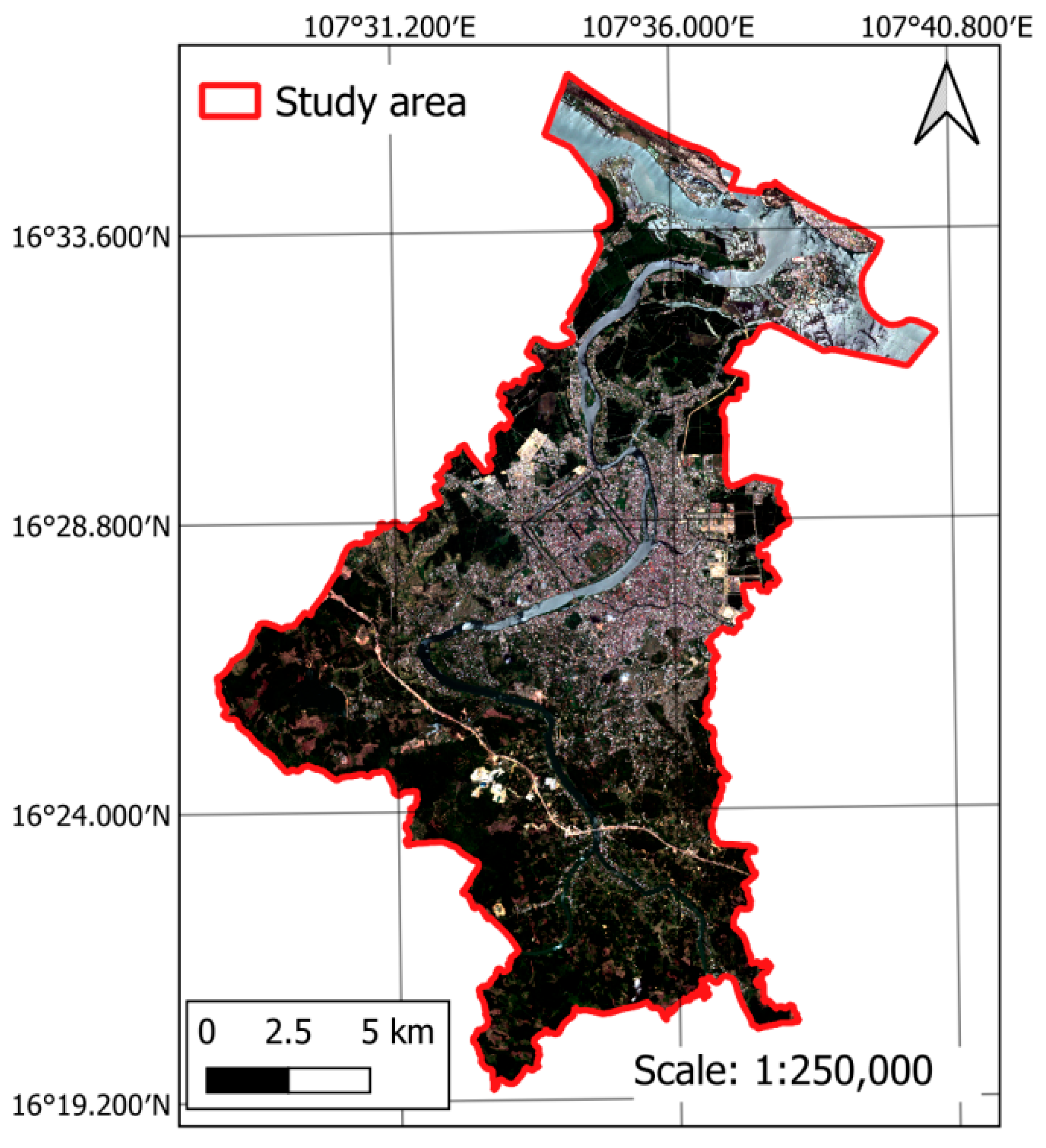

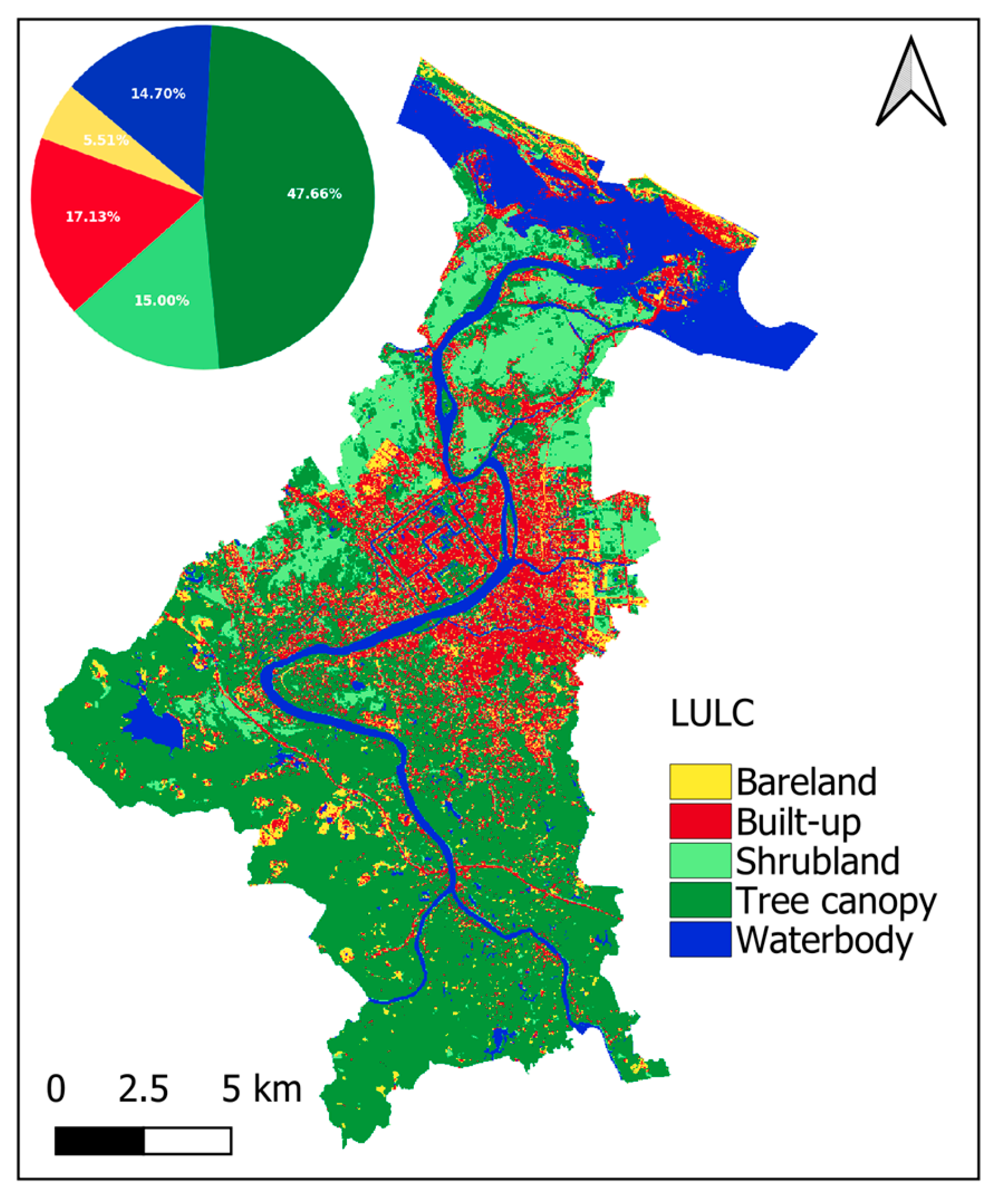
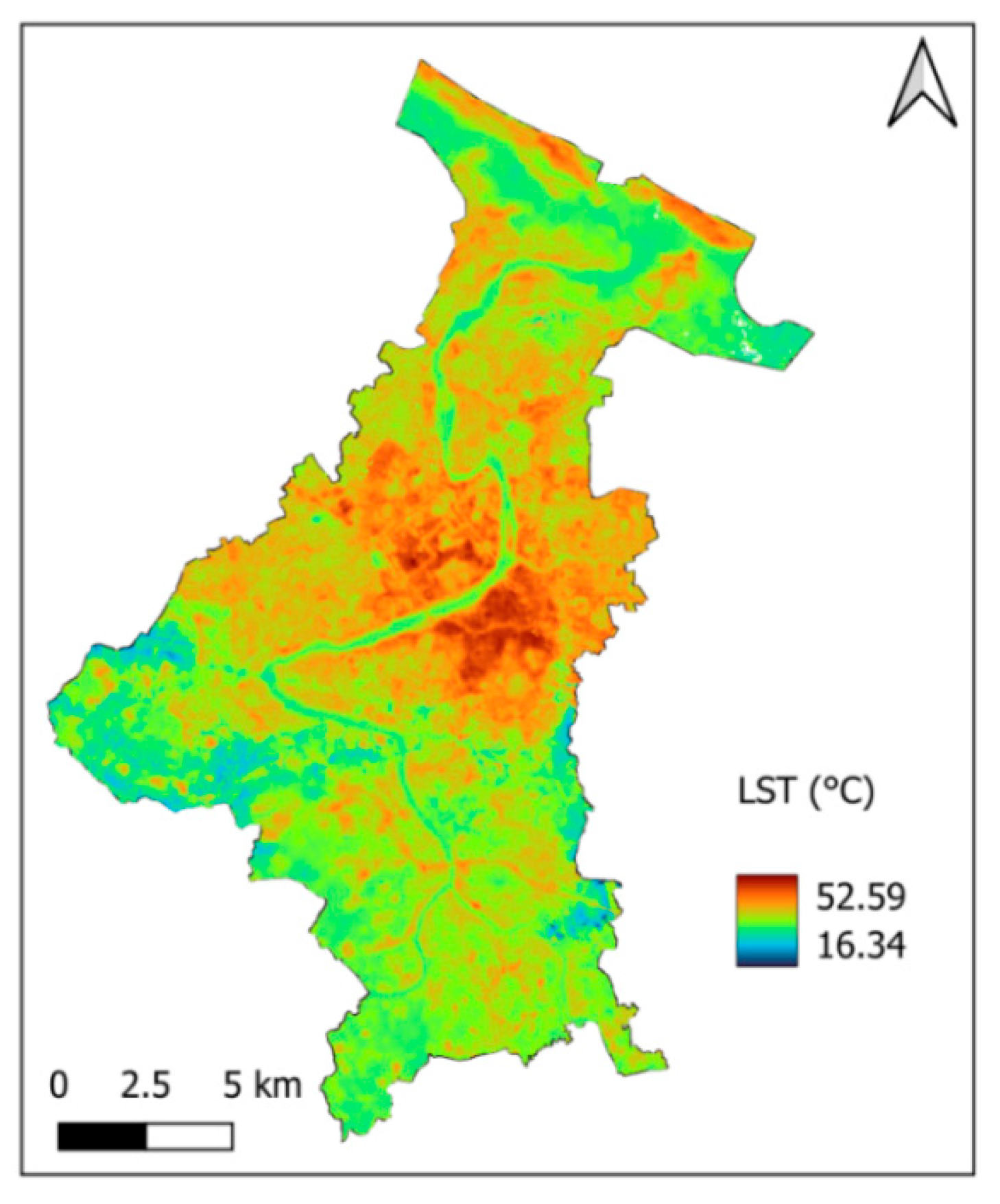
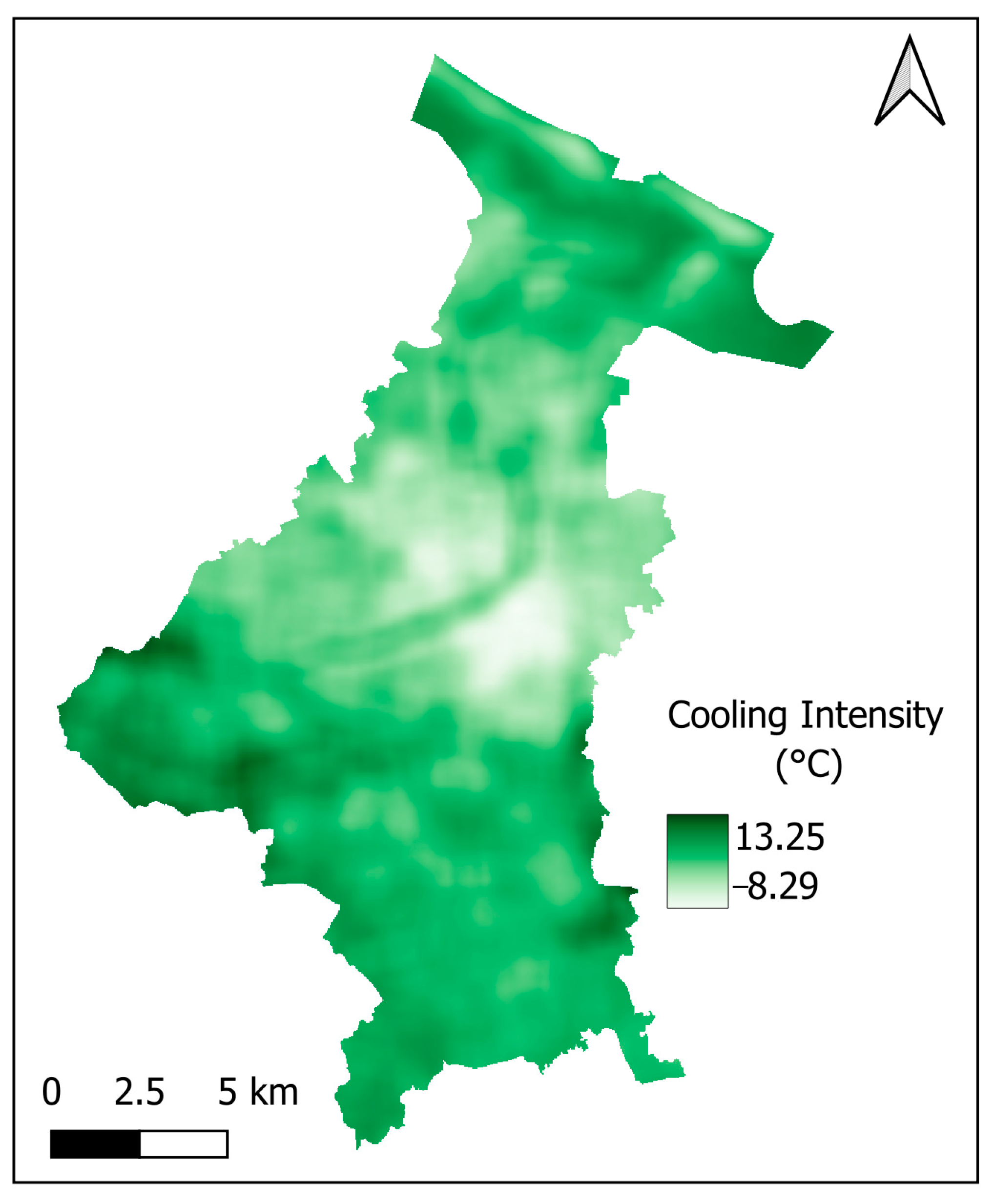
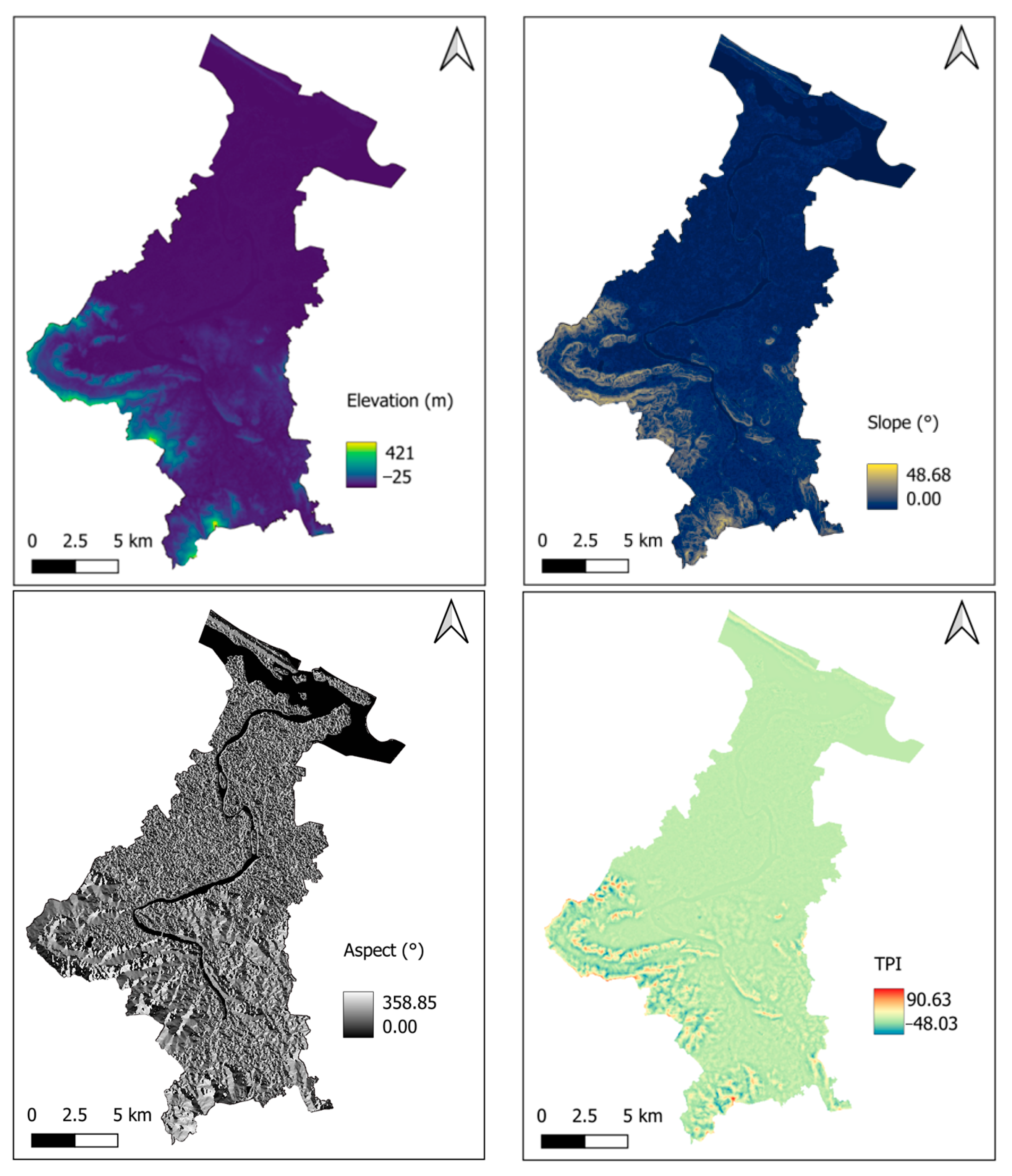

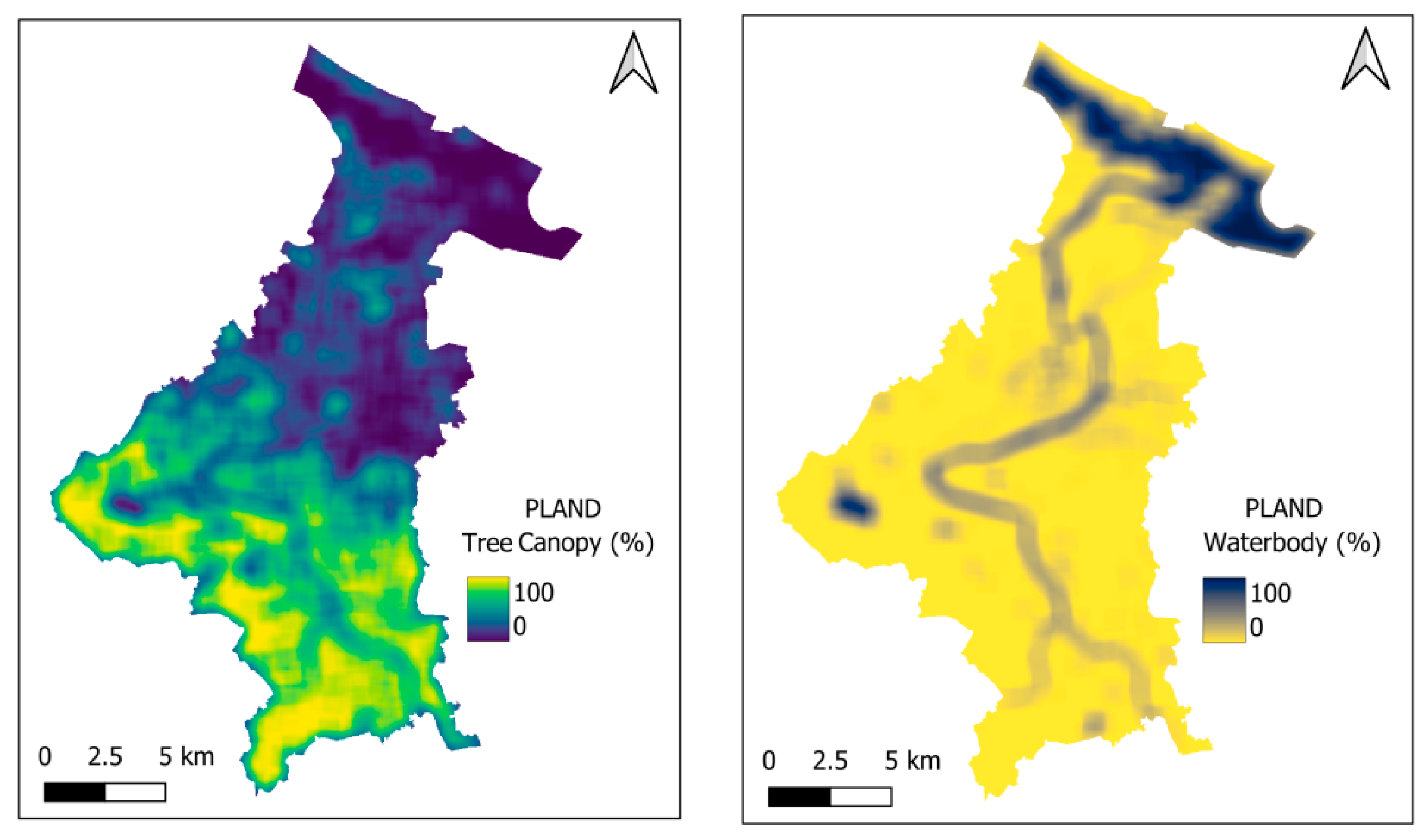
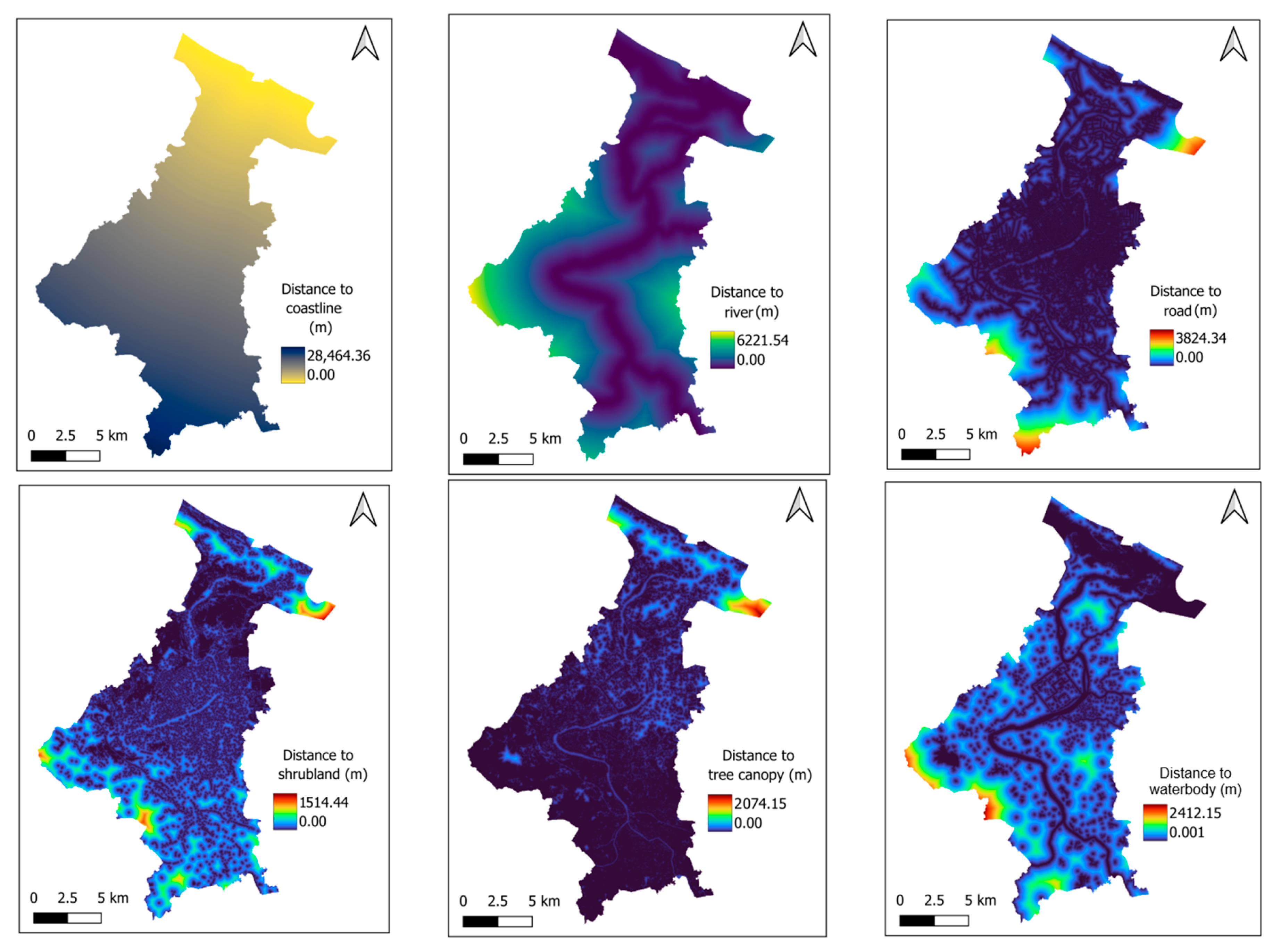




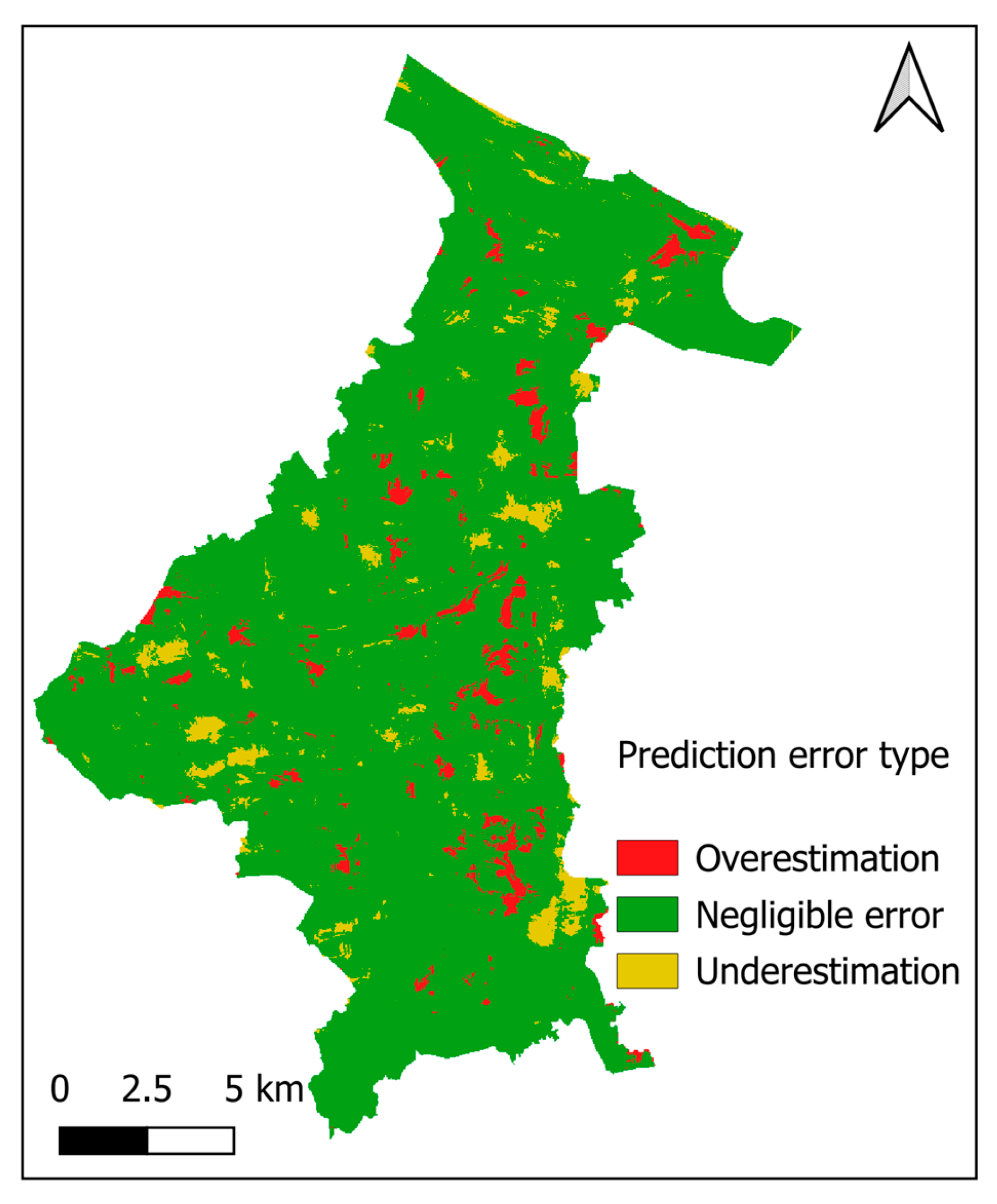
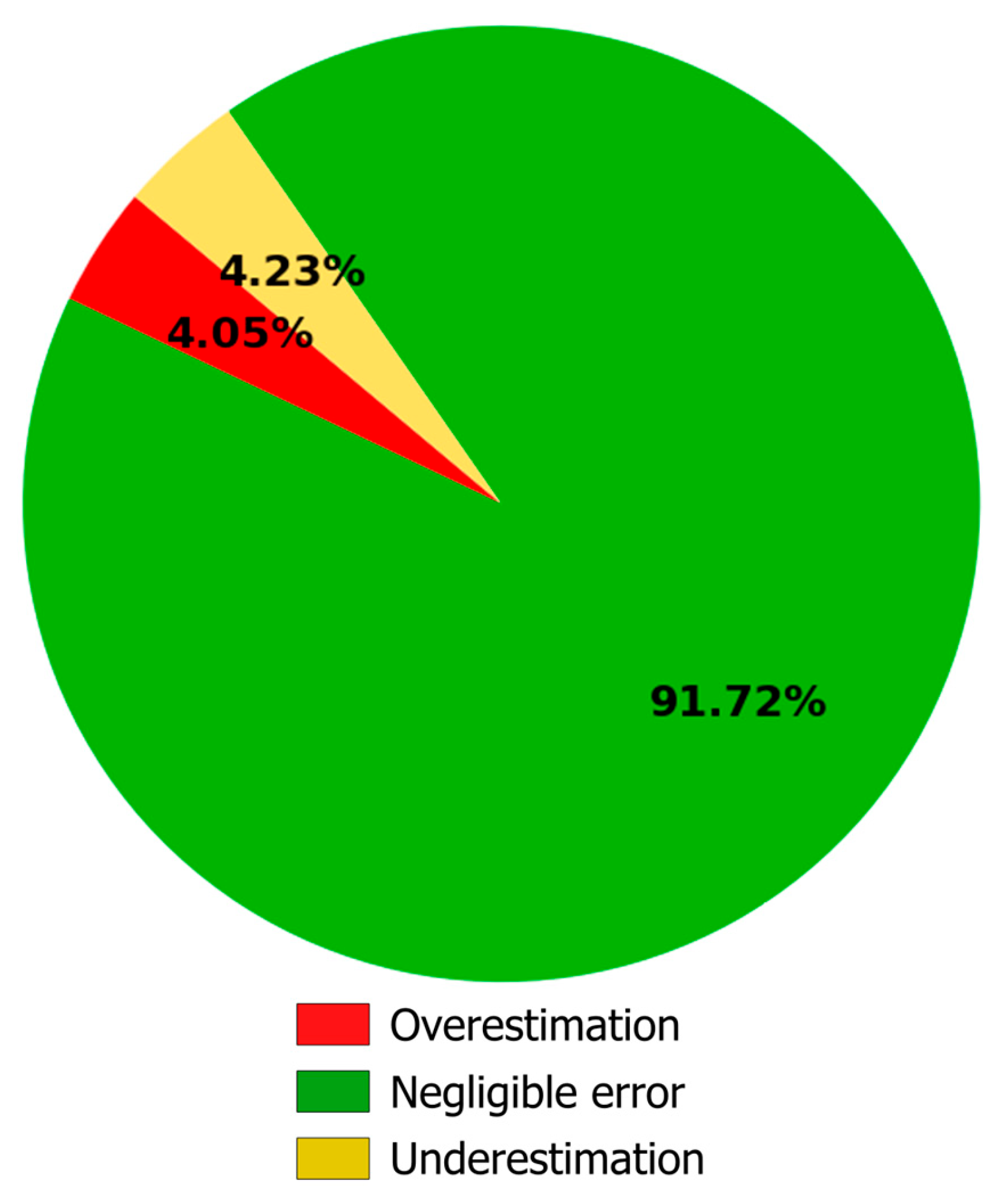


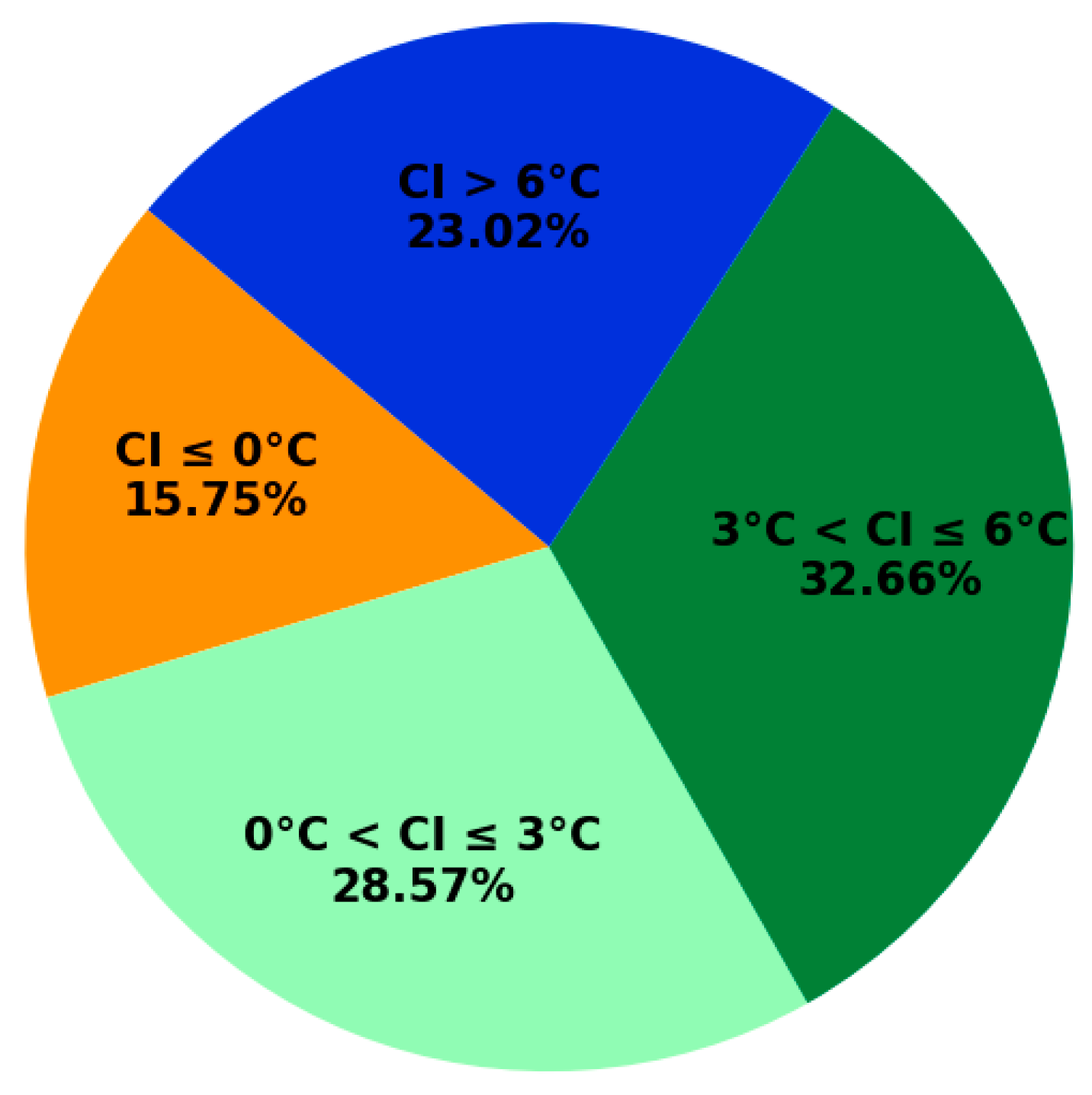
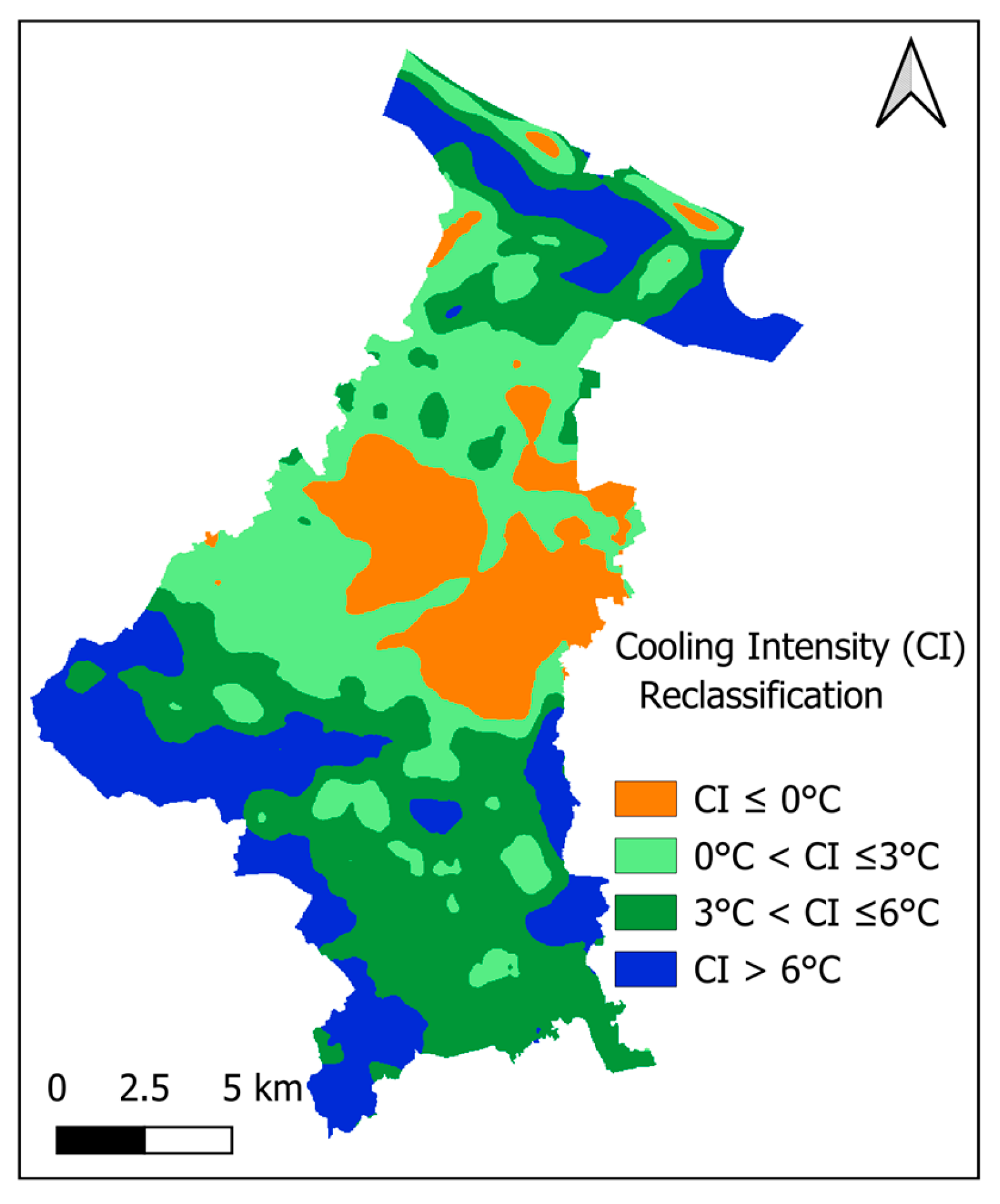
| Dataset | Time Period | Bands | Spatial Resolution |
|---|---|---|---|
| Landsat 8 | 1 May 2024–30 September 2024 | SR_4, SR_5, and ST_B10 | 30 m |
| NASA SRTM Digital Elevation 30 m | Elevation | 30 m | |
| Sentinel-2 | 1 January 2024–31 December 2024 | B2, B3, B4, B5, B6, B7, B8, B8A, B11, B12 | 10 m (B2, B3, B4, and B8) 20 m (B5, B6, B7, B8A, B11, and B12) |
| LULC Class | Accuracy Rate | Precision | Recall | F1 Score | Cohen’s Kappa Coefficient |
|---|---|---|---|---|---|
| Bareland | 0.89 | 0.88 | 0.89 | 0.89 | 0.85 |
| Built-up | 0.89 | 0.88 | 0.89 | 0.89 | 0.85 |
| Vegetation | 0.98 | 0.96 | 0.98 | 0.97 | 0.96 |
| Waterbody | 0.96 | 0.99 | 0.96 | 0.97 | 0.97 |
| Variable | Variable Name | Unit | Min | Average | Mean | Max |
|---|---|---|---|---|---|---|
| X1 | Elevation | m | 0.00 | 22.02 | 36.04 | 291.35 |
| X2 | Slope | m | 0.00 | 4.99 | 4.86 | 27.24 |
| X3 | Aspect | ° | 0.00 | 143.23 | 41.97 | 273.91 |
| X4 | TPI | -- | −12.14 | 0.00 | 1.67 | 17.44 |
| X5 | PLAND bareland | % | 0.00 | 5.21 | 5.63 | 52.67 |
| X6 | PLAND shrubland | % | 0.00 | 14.14 | 19.65 | 97.33 |
| X7 | PLAND tree canopy | % | 0.00 | 45.57 | 31.42 | 100.00 |
| X8 | PLAND waterbody | % | 0.00 | 14.11 | 23.42 | 100.00 |
| X9 | Distance to coastline | m | 144.70 | 13,806.35 | 7219.54 | 28,351.14 |
| X10 | Distance to river | m | 0.00 | 1311.74 | 1209.19 | 6185.10 |
| X11 | Distance to road | m | 9.73 | 231.45 | 354.86 | 2264.72 |
| X12 | Distance to shrubland | m | 0.65 | 144.61 | 153.20 | 1449.34 |
| X13 | Distance to tree canopy | m | 0.00 | 75.58 | 179.46 | 1886.43 |
| X14 | Distance to waterbody | m | 0.00 | 273.91 | 269.16 | 2313.60 |
| Y | Cooling intensity | °C | −8.11 | 3.31 | 3.46 | 13.20 |
Disclaimer/Publisher’s Note: The statements, opinions and data contained in all publications are solely those of the individual author(s) and contributor(s) and not of MDPI and/or the editor(s). MDPI and/or the editor(s) disclaim responsibility for any injury to people or property resulting from any ideas, methods, instructions or products referred to in the content. |
© 2025 by the authors. Licensee MDPI, Basel, Switzerland. This article is an open access article distributed under the terms and conditions of the Creative Commons Attribution (CC BY) license (https://creativecommons.org/licenses/by/4.0/).
Share and Cite
Tran, V.-D.; Hoang, N.-D. Machine Learning Insight into the Cooling Intensity of Urban Blue-Green Spaces During Heatwaves. Sustainability 2025, 17, 9824. https://doi.org/10.3390/su17219824
Tran V-D, Hoang N-D. Machine Learning Insight into the Cooling Intensity of Urban Blue-Green Spaces During Heatwaves. Sustainability. 2025; 17(21):9824. https://doi.org/10.3390/su17219824
Chicago/Turabian StyleTran, Van-Duc, and Nhat-Duc Hoang. 2025. "Machine Learning Insight into the Cooling Intensity of Urban Blue-Green Spaces During Heatwaves" Sustainability 17, no. 21: 9824. https://doi.org/10.3390/su17219824
APA StyleTran, V.-D., & Hoang, N.-D. (2025). Machine Learning Insight into the Cooling Intensity of Urban Blue-Green Spaces During Heatwaves. Sustainability, 17(21), 9824. https://doi.org/10.3390/su17219824









